
Gibbons are apes in the family Hylobatidae. The family historically contained one genus, but now is split into four extant genera and 20 species. Gibbons live in subtropical and tropical rainforests from eastern Bangladesh to Northeast India to southern China and Indonesia.
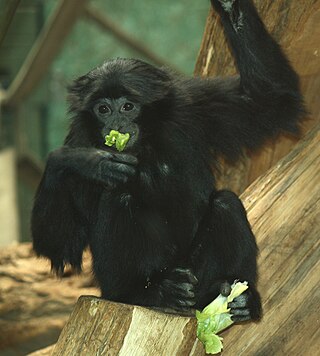
The siamang is an endangered arboreal, black-furred gibbon native to the forests of Indonesia, Malaysia, and Thailand. The largest of the gibbons, the siamang can be twice the size of other gibbons, reaching 1 m (3.3 ft) in height, and weighing up to 14 kg (31 lb). It is the only species in the genus Symphalangus. Fossils of siamangs date back to the Middle Pleistocene.

The lar gibbon, also known as the white-handed gibbon, is an endangered primate in the gibbon family, Hylobatidae. It is one of the better-known gibbons and is often kept in captivity.
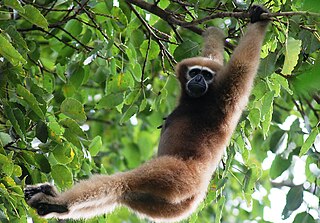
The hoolock gibbons are three primate species of genus Hoolock in the gibbon family, Hylobatidae, native to eastern Bangladesh, Northeast India, Myanmar, and Southwest China.
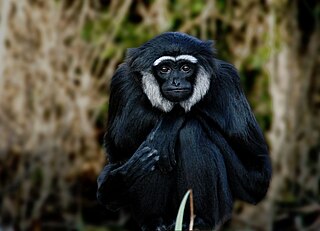
The agile gibbon, also called the black-handed gibbon, is an Old World primate, and is a part of the gibbon family. It is native to Indonesia, specifically, on the island of Sumatra. The agile gibbon can also be found in Malaysia, and southern Thailand. As appointed by the IUCN Red List, this species is endangered, and mainly due to the destruction of their habitat and pet trade.

The silvery gibbon, also known as the Javan gibbon, is a primate in the gibbon family Hylobatidae. It is endemic to the Indonesian island of Java, where it inhabits undisturbed rainforests up to an altitude of 2,450 m (8,040 ft). It has been listed as Endangered on the IUCN Red List since 2008, as the wild population is estimated to comprise less than 2500 mature individuals.
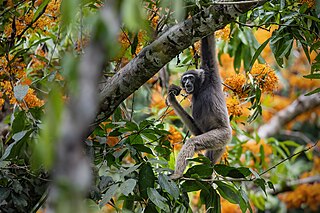
Müller's gibbon, also known as the southern grey gibbon, is a primate in the gibbon family, Hylobatidae.

The pileated gibbon is a primate in the gibbon family, Hylobatidae.

Kloss's gibbon, also known as the Mentawai gibbon, the bilou or dwarf siamang, is an endangered primate in the gibbon family, Hylobatidae. It is identifiable in that it is all black, resembling the siamang with its black fur, but is considerably smaller and lacks the siamang's distinctive throat pouch. Kloss's gibbon reaches a size 17 to 25 inches and weigh at most 13 pounds (6 kg). As is the case for all gibbons, they have long arms and no tail. Males and females are difficult to distinguish.

The genus Hylobates is one of the four genera of gibbons. Its name means "forest walker", from the Greek hūlē and bates.
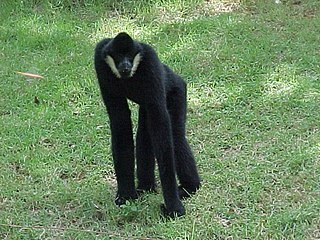
The northern white-cheeked gibbon is a Critically Endangered species of gibbon native to South East Asia.
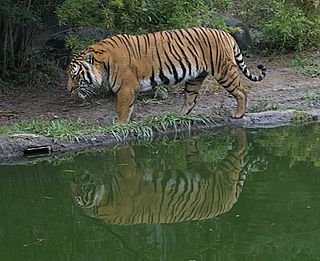
The wildlife of Laos encompasses the animals and plants found in the Lao People's Democratic Republic, a landlocked country in southeastern Asia. Part of the country is mountainous and much of it is still clad in tropical broadleaf forest. It has a great variety of animal and plant species.

The Hainan black-crested gibbon or Hainan gibbon, is a Critically Endangered species of gibbon found only on Hainan Island, China. It was formerly considered a subspecies of the eastern black crested gibbon from Hòa Bình and Cao Bằng provinces of Vietnam and Jingxi County in Guangxi Zhuang Autonomous Region, China. Molecular data, together with morphology and call differences, suggest it is a separate species. Its habitat consists of broad-leaved forests and semi-deciduous monsoon forests. It feeds on ripe, sugar-rich fruit, such as figs and, at times, leaves, and insects.

The southern white-cheeked gibbon is a species of gibbon native to Vietnam and Laos. It is closely related to the northern white-cheeked gibbon and the yellow-cheeked gibbon ; it has previously been identified as a subspecies of each of these.

The Sumatran lar gibbon, also known as the Sumatran white-handed gibbon, is a subspecies of the lar gibbon, a primate in the gibbon family Hylobatidae. It is native to the island of Sumatra, Indonesia. It shares the tree tops with orangutans, which, like the gibbon, rarely come out of the trees due to predators, such as tigers and possibly sun bears.
The Yunnan lar gibbon, also known as the Yunnan white-handed gibbon, is a subspecies of the lar gibbon, a primate in the gibbon family, Hylobatidae. This Chinese subspecies is thought to be extinct.

The Bornean white-bearded gibbon, also known as the Bornean agile gibbon or southern gibbon, is a species of gibbon endemic to southern Borneo. It is an endangered species, due to the ongoing logging of tropical forests between the Kapuas and Barito rivers. Additional issues of concern to the endangerment of white-bearded gibbons also threaten other arboreal primates.

Carpenter's lar gibbon is an endangered subspecies of white-handed gibbon, also known as the lar gibbon. It is listed as an endangered species because it is believed to have undergone a decline of more than 50% in the prior three generations due to loss of forest habitat and loss of mature individuals to hunting. The subspecific name honors primatologist Clarence R. Carpenter.

The central lar gibbon is a subspecies of white-handed or lar gibbon that is vulnerable to extinction. It is endemic to Malaysia, Myanmar, and Thailand.



















